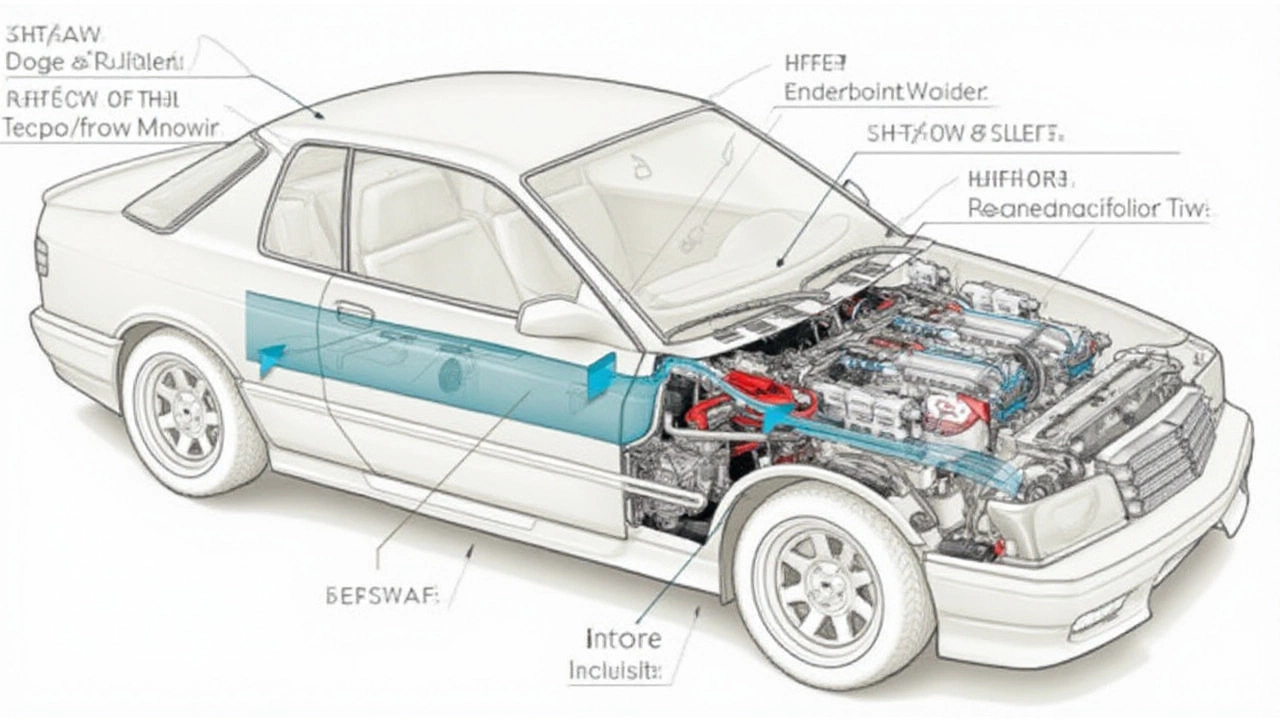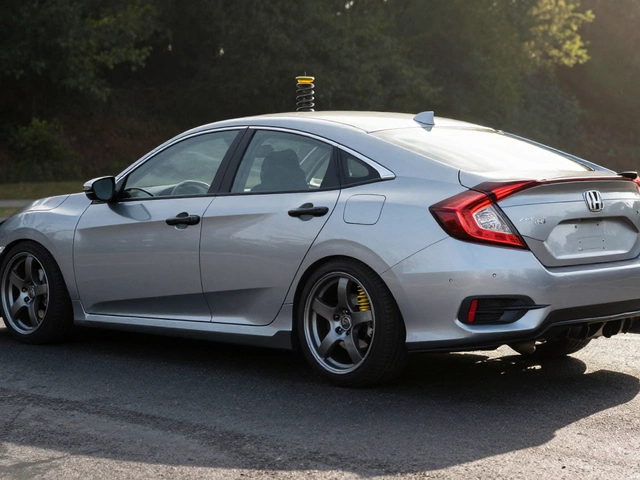When it comes to enhancing your vehicle's performance, a K&N drop-in filter often catches the eye of car enthusiasts. This small yet effective upgrade offers a straightforward way to potentially increase your vehicle's horsepower. But just how much horsepower can you really gain? This is a question that sparks curiosity and debate among gearheads.
In this article, we're diving into the world of performance air filters, focusing particularly on the mechanics and benefits of K&N drop-in filters. We'll explore what makes these filters unique, the potential horsepower gains you can expect, and some practical tips on installation. We'll also tackle some common myths and misconceptions surrounding filter upgrades. Whether you're looking to unlock a bit more power from your daily driver or fine-tune your race car, understanding how these filters work is key to making an informed decision.
- Understanding Performance Air Filters
- How K&N Filters Boost Horsepower
- Real-World Power Gains
- Installation Tips for Optimal Performance
- Debunking Common Myths
Understanding Performance Air Filters
Performance air filters are incredible tools for anyone looking to boost their engine's output with minimal alteration to their vehicle. Unlike standard air filters, which prioritize trapping the smallest particles and ensuring the longest filter life, performance variants such as the K&N filter are designed to increase the amount of air that flows into the engine. This increased airflow directly influences the engine's ability to perform better by allowing it to burn fuel more efficiently, which leads to increased horsepower gain. This isn't just about making a car go faster—it's about enhancing the overall driving experience by optimizing how power is delivered.
The difference lies primarily in the filter media materials and design. Cotton gauze, found in K&N filters, is often layered and oiled, designed to both trap dirt particles and let more air through. This contrasts with the dense paper used in conventional filters which can be more restrictive to airflow. It's not just about the material itself, though. The design of the filter plays an important role too, with flatter pleats allowing for more surface area and, therefore, greater air passage. The interaction between these elements is what makes these filters stand out from the standard issue. It might not seem like a big deal at first, but the way air freely flows into the engine can substantially change how the vehicle behaves during those intense throttle surges.
Market researchers have found that performance filters like K&N can enhance engine power by anywhere between 1-4 horsepower, depending on the vehicle. These numbers might seem modest, but they can be quite noticeable when it comes to high-performance machines or spirited driving. In the context of racing or speed enthusiasts, every increment of power matters when dealing with competitive lap times or that anxious zero to sixty measure. For instance, a dyno test reported by a noteworthy automotive magazine highlighted a marked increase in wheel horsepower in a popular sports car, just from swapping out its stock air filter for a performance variant.
There is a scientific backbone to the improvements offered by these filters. In simple terms, more air means more combustion; more combustion means more power. An engine fundamentally operates on the principle of sucking in air and mixing it with fuel to create power, so naturally, if you allow more air in a controlled manner, the engine can push itself to produce more power. This is where the concept of engine power being unlocked comes into play. Often misunderstood or underestimated, swapping in a performance air filter is one of the least invasive yet most rewarding modifications anyone can make.
Given these advantages, it's not surprising that performance air filters have become a staple for car enthusiasts everywhere. However, they offer benefits beyond appealing just to the desire for more speed. These filters are reusable and easily washable, offering a more environmentally friendly option than your typical disposable air filters. It cuts down on waste while also saving money over time, as you won't need to buy replacements nearly as often. If you're looking to enhance your car's performance while being kind to Mother Earth, they certainly make a compelling case.
A top engineer at K&N once said, "Our filters are designed not just to make your engine breathe better but to make you breathe easier knowing you're using a product that’s built to last."
How K&N Filters Boost Horsepower
There's something almost magical about a sleek, well-tuned engine, roaring to life with just the right tweak. The secret to unlocking extra power often lies in the air your engine breathes. Enter the K&N filter. Known for its remarkable ability to let engines inhale more effortlessly, this performance air filter has become a staple for enthusiasts seeking extra horsepower. But why exactly does it make a difference? Well, the key is in its design. Unlike conventional paper filters, a K&N filter uses layers of oiled cotton gauze layered between aluminum wire mesh. This not only enhances durability but also increases airflow dramatically. More air means more fuel can be burned, which means increased power and efficiency.
One of the notable advantages of a K&N filter is its ability to maintain optimal filtration while still enhancing horsepower. The cotton gauze provides an extraordinary level of filtration. It's like the engine's lungs can finally take a full, enriching breath, reducing the strain and boosting engine power output. Tests have shown that adding a K&N filter can result in a horsepower increase of 1 to 4 HP, depending on your particular vehicle and driving conditions. It might not sound monumental, but every bit counts, especially if you're optimizing your ride for peak performance.
The Science Behind the Power
Watering the lawn with a hose is easy. But what if you wanted to cover more ground? You'd need more pressure or a wider hose, right? Your engine operates on much the same principle. The K&N filter allows for increased air passage, akin to widening that hose. When combined with a well-calibrated fuel system, this creates an engine environment rich in oxygen, ready to take on the challenges of the road. The result is a vehicle that feels much livelier, more responsive at the throttle."The reduction in restriction and the subsequent improved intake are among the primary reasons many drivers switch to K&N filters," states a report by Auto Performance Weekly.These filters are reusable after cleaning, offering another layer of appeal—both economic and environmental. Unlike disposable filters, you can maintain a K&N filter's performance by simply cleaning and re-oiling it. This not only saves money in the long run but also contributes to less waste.
Knowing these benefits, you may wonder what potential drawbacks might exist. Well, it's essential to be cautious about oil application. Over-oiling can lead to fouling of the MAF sensor (Mass Air Flow sensor), which could impact performance adversely. But when properly maintained, a K&N filter can be a game-changer, significantly boosting your vehicle's horsepower while also extending its lifespan. It's a high-impact, cost-effective upgrade that taps into the science of airflow, fueling your engine's quest for more horsepower with precision and reliability.

Real-World Power Gains
Experimenting with performance enhancements like the K&N filter sparks excitement amongst car enthusiasts. There's often a hot debate about how much power you can squeeze out of your engine with these high-performance air filters. The truth lies somewhere in the actual data and user experiences. By understanding how a K&N filter works, it becomes evident that the potential horsepower gain can vary. While some tests have demonstrated gains of up to 1 to 4 horsepower, especially when the engine is delivering high RPMs, the true value often lies in improved throttle response and engine efficiency.
Let's talk about why only a few extra horsepower can matter. Consider that adding a mere 2 to 3 % improvement to your vehicle's horsepower can result in a noticeable difference in performance, particularly when accelerating from higher speeds. It's not just about raw power; it's about how the engine breathes and responds. A properly flowing air system, courtesy of a clean performance filter, reduces the strain on your engine, making it feel more alive. In some scenarios, drivers claim richer engine sounds, quicker acceleration, and enhanced fuel economy.
"Regarding ordinary driving, a high-performance air filter can give you more confidence in the car’s ability to respond," says a veteran automotive journalist. "The gains may seem marginal on paper, but the real-world driving experience often tells a more compelling story."
Now, you might ask, "What's the science behind these claims?" The secret lies in the ability of the K&N filter to allow for greater air intake – vital for engine combustion. More air can mean more power, and its cotton gauze with oil technology captures particulates much better than traditional paper filters without choking off airflow. There's also the factor of reusability. A K&N filter can be cleaned and reused, often lasting longer than the life of your vehicle, making it not just a performance upgrade but also a cost-effective investment in the long run.
Real-world application and data
This is where things get interesting. In independent tests, drivers of midsize sedans, sports cars, or SUVs have noted significant improvements with a performance filter installed. Typically, these modifications tend to cater more effectively to vehicles with optimized or high-output engines. Under such conditions, a K&N filter shines vividly. Imagine driving a high-performance muscle car designed for the track—here, any gains, even if minute, become palpable. For those with turbocharged or naturally aspirated multi-cylinder engines, the improvements expand beyond a mere number to an enriched driving narrative.
| Vehicle Type | Horsepower Gain | Source |
|---|---|---|
| Standard Sedan | 1-2 HP | Automotive Testing Insights |
| Sports Car | 3-5 HP | Performance Magazine Study |
| SUV | 2-3 HP | Consumer Reports |
So if you're looking to give your car a subtle but appreciable boost, a K&N filter might just be the tool to enhance your driving pleasure. Enjoy the smoother throttle response and a deeper appreciation for what your vehicle can deliver.
Installation Tips for Optimal Performance
Getting the most out of a K&N drop-in filter isn't just about purchasing the right product; it’s about installing it efficiently to reap the horsepower gain you’re looking for. Before you dive under the hood, make sure to read the instructions that come with your specific filter model. Each car might have its quirks, but there's a general process that applies to most vehicles. Start by ensuring your engine is cool to the touch. Working under the hood on a hot engine is not only uncomfortable but can be dangerous.
As you prepare to install the filter, clean the area around your airbox. Dust and debris can easily find their way into your engine and compromise performance, negating the benefits of your new filter. With the area clean, carefully remove the old air filter. Take your time to note how it fits into the airbox, since inserting the new air filter in the same orientation can make a big difference in performance and longevity.
"A clean air filter improves engine performance, which can lead to increased fuel efficiency and lowered emissions," says automotive expert and author, John Miller.
Securing the Filter
Once you've removed the old filter and prepped the area, it's time to place your new K&N filter. Gently slide it into place without forcing it—ensuring all edges are snugly fit within the airbox. A loose filter could allow dirt to bypass the filter entirely, causing engine damage over time. After you’ve ensured a tight fit, reassemble your airbox components securely. Double-check all clips and screws and make sure they’re tightened, as you wouldn’t want any parts to shake loose while driving.
Troubleshooting Common Issues
If after installation, you notice any unusual sounds or performance changes, there might be an issue with how the filter is seated. Remove it, inspect for any debris or inadequately sealed edges, and try again. An incorrectly installed filter can cause the engine to work harder than necessary, impacting the engine power output. Don’t be hesitant to revisit the steps or consult with fellow enthusiasts who have walked this path before. Regular inspection and maintenance of your filter will also ensure its performance benefits last, reinforcing the effort you’ve put into this upgrade.

Debunking Common Myths
When it comes to upgrading engines with performance air filters like the K&N filter, many drivers tend to have a few misconceptions. One popular myth is the idea that installing one of these filters automatically transforms any car into a race-ready machine. While it’s true that high-flow air filters can improve air intake, offering a potential boost in power, it's crucial to understand that the difference isn't typically as dramatic as some might believe. For most vehicles, the increase hovers around a modest 1-4% in horsepower. This can feel significant in some cases, but doesn’t turn an economy car into a sports car overnight.
Another common myth is that once these filters are in place, they require zero maintenance. That's a misconception. Like many components in a car, K&N filters benefit from regular cleaning and maintenance to perform optimally. The added advantage is that they’re reusable, which means you don’t need to replace them as often as standard paper filters. However, this longevity comes with the need to clean and oil the filter periodically, typically around every 50,000 miles or as your driving conditions dictate.
Some skeptics argue that performance filters can harm engines by letting in too much dirt. While it’s a more contentious topic, studies and manufacturer tests indicate that when properly maintained, these filters are engineered to strike a balance between air flow and filtration efficiency. According to a
report by Engineering Explained, a well-maintained high-flow filter can match, if not exceed, the filtration ability of conventional paper filters.This myth may stem from instances where neglect or incorrect installation led to issues, highlighting the importance of adherence to maintenance schedules and installation guidelines.
Let’s tackle the myth that a K&N filter voids vehicle warranties. This is a persistent belief that often scares potential users away. The Magnuson-Moss Warranty Act protects consumers, meaning that the use of an aftermarket product, like a K&N filter, doesn’t void your warranty unless the manufacturer can prove it caused damage. This means you can enjoy the potential benefits of enhanced air flow without the fear of losing warranty coverage, provided the part doesn't cause direct damage.
Filtering Out the Facts
Understanding the fine print is essential. Claims that these filters significantly improve fuel economy are often overstated. Yes, improved air flow might lead to a marginal increase in fuel efficiency, but it won’t be dramatic nor will it heavily impact all vehicles. The effect varies widely, influenced by the specific make, model, and driving conditions. There are reports of improved throttle response and slight mpg gains, but they are more pronounced in performance-focused vehicles rather than everyday sedans or trucks.
The conversation around horsepower gain with these filters often circles back to expectations versus reality. Noticing the most significant differences usually requires other modifications beyond just a filter swap. An entire performance upgrade package, involving exhaust systems, intakes, and tuning, often works in harmony to bring out tangible results. It's when coupled with these elements that a performance filter shines more brightly, making it a piece of a larger puzzle rather than a standalone powerhouse.






